EU single use plastics directive consultation: impact assessment - environmental report
Environmental report for a consultation on the introduction of new legislation to restrict the supply of seven single-use plastic items and all oxo-degradable products, in Scotland, with the intended effect of reducing the volume and impact of plastic pollution within terrestrial and marine environments.
4. Climatic Factors
For the purposes of this assessment, the term is concerned with increasing the likelihood of climate change effects through greenhouse gas emissions, and the ability to adapt to the effects of climate change such as the occurrence of more extreme weather events.
The Carbon Impacts of the Circular Economy (2015)[36] states that over two thirds of Scotland's' carbon footprint is directly related to material consumption and waste. Although the amount of single-use plastics targeted in this proposed strategy is relatively low, the proposed measure is expected to achieve carbon savings as it encourages the shift from high-carbon fossil fuel material (i.e., plastics) to low-carbon material (e.g. paper, cardboard, or wood).
This section provides the contextual information to inform the assessment (in terms of the review of Plans, Programmes and Strategies (PPS) and the baseline information) as well as an assessment of the effects of the SUP Directive on climate change.
4.1 Relationship with other Plans, Programmes and Strategies and Environmental Objectives
The PPS that are relevant to the climatic change topic area are shown in Figure 4‑1 and summarised thereafter.
For the purposes of the review of the international plans and programmes for this SEA, it is assumed that the broad objectives of extant European Union (EU) legislation will be maintained once the UK has withdrawn from the EU and that similar or equivalent environmental protections will remain in place.
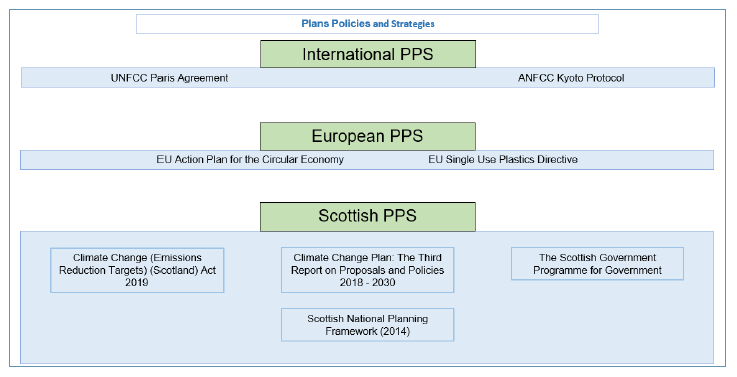
The relationship between the identified PPSs and the market restriction of specified single-use plastic items are outlined below:
The United Nations Framework Convention on Climate Change (UNFCCC) sets an overall framework for international action to tackle the challenges posed by climate change. The Convention sets an ultimate objective of stabilising greenhouse gas concentrations "at a level that would prevent dangerous anthropogenic (human induced) interference with the climate scheme." The Convention requires the development and regular update of greenhouse gas emissions inventories from industrialised countries, with developing countries also being encouraged to carry out inventories. The countries who have ratified the Treaty, known as the Parties to the Convention, agree to take climate change into account in such matters as agriculture, industry, energy, natural resources and where activities involve coastal regions. The Parties also agree to develop national programmes to slow climate change. The two main agreements resulting from the UNFCCC to date are the Kyoto Protocol (1997) and the Paris Agreement (2015).
The Kyoto Protocol is an international agreement linked to the United Nations Framework Convention on Climate Change (UNFCCC). It was adopted on 11 December 1997 to establish an international mechanism to reduce emissions of greenhouse gas emissions and in consequence set binding emissions reduction targets for 37 industrialised countries and the European Community. These targets equated to an average of 5% reductions relative to 1990 levels over the five-year period 2008-12. The key distinction between this and the UNFCCC is that the Convention encourages nations to stabilise greenhouse gases while the Kyoto Protocol committed them to doing so through greenhouse gas reductions. It included three market-based mechanisms to meet these targets: emissions trading; the clean development mechanism (CDM); and Joint Implementation (JI).
The Paris Agreement was adopted by those parties attending COP-21 in December 2015. It was signed by 197 UNFCCC members and at the time of writing has been ratified by 190 of these. Its aim is to keep global temperature rise this century well below 2°C above pre-industrial levels and to pursue efforts to limit the temperature increase even further to 1.5°C. Additionally, the agreement aims to strengthen the ability of countries to deal with the impacts of climate change. It discusses the importance of limiting emissions from waste management. The introduction of market restrictions would contribute to the limiting and reduction of emissions relating to waste management by stimulating a shift away from emissions intensive single-use plastic manufacture towards reusable, more sustainable and less carbon intensive alternative products.
European Union (2018): The EU Action Plan for the Circular Economy details an EU Action Plan for the Circular Economy. The Action Plan includes a suite of programmes seeking to embed improved practices across the lifecycle of products from cradle to grave. The wider benefits of adopting a circular economy contribute to helping tackle climate change and lower current emissions levels. The revised legislative proposals on waste set clear targets for waste reductions. Key elements of the revised waste proposal include:
- A common EU target for recycling 65% of municipal waste by 2030;
- A common EU target for recycling 75% of packaging waste by 2030;
- A binding landfill target to reduce landfill to maximum of 10% of municipal waste by 2030;
- A ban on landfilling of separately collected waste; and
- Promotion of economic instruments to discourage landfilling.
The Action Plan strongly advocates a shift away from resource intensive, linear consumption models that are characterised and compounded by the current role of single-use plastic items in propagating a 'throwaway' mentality in Scotland and further afield. Restricting such products within Scotland would likely stimulate the development of more sustainable and reusable alternatives, each of which would contribute to the national effort to exceed recycling targets and to decrease emissions resulting from the unnecessary disposal of waste. The Plan also pushes member states to radically enhance waste management and recycling practices; to design out waste and to design products that can be recycled (if not repaired/remanufactured) at end of life
European Union (2019): Directive on the Reduction of the Impact of Certain Plastic Products on the Environment highlights the significant negative environmental, health and economic impact of certain plastic products with a particular focus on single-use plastic items. the Directive builds upon the European Strategy for Plastics in the Circular Economy through a specific legal framework which aims to increase the level of ambition demonstrated through national measures to prevent and reduce litter with specific reference to single-use plastics. Key elements of the enhanced Directive include:
- National measurable quantitative reductions in the production and consumption of single-use plastic products, harmonised technical standards, enhanced product design and differential labelling standards.
- The prioritisation of sustainable renewable non-toxic products and re-use systems/services over single-use plastic items.
- The introduction of Extended Producer Responsibility (EPR) systems which recognise the costs associated with the management and clean up single-use plastic items.
The directive highlights the link between single-use plastic items, plastic litter in terrestrial and aquatic ecosystems and microplastic pollution, and draws attention to the significant negative environmental, health and economic impact of such plastic products and associated deleterious materials. Restricting such materials in Scotland could therefore make a significant reduction in plastic-related carbon emissions and plastic pollution and could save UK municipalities up to £18 million in clean-up costs per annum.
Climate Change (Emissions Reduction Targets) (Scotland) Act 2019
Receiving Royal Assent on 31 October 2019, the Act amends the Climate Change (Scotland) Act 2009 and sets targets for the reduction of greenhouse gases emissions towards a legally binding net-zero carbon target by 2045. This Act represents Scotland's contribution to the worldwide effort to deliver on the Paris Agreement that was reached at the 21st Conference of the Parties of the United Nations Framework Convention on Climate Change.
Scottish Government (2018): Climate Change Plan - The Third Report on Proposals and Policies 2018-2032 sets out details of the approach to cut emissions up to 2032. It states targets to recycle 70% of all waste by 2025, reduce waste sent to landfill to 5% by 2025, and establish a more circular economy, where goods and materials are kept in use for longer and where the value of resources is preserved and maintained for as long as possible. Single-use plastics and reducing reliance thereon are specifically targeted within the plan.
Scottish Government (2020-21): The Scottish Government Programme for Government states the Government's commitment to tackle climate change and to prepare Scotland for the new, low carbon world. The programme commits the government to reducing the demand for and associated impacts of virgin containers, as well as promoting the capture and recycling of existing material. The programme will also commit £500,000 to address litter sinks around the coast and to develop policy which addresses marine plastics. In the context of climate change, the programme seeks to realise carbon benefits by stimulating an increase in recycling rates and a reduction in production-related emissions, as well as a reduction in littering and associated emissions.
Scottish Government (2014): The Scottish National Planning Framework (NPF) 3 provides the spatial expression of the Scottish Government's Economic Strategy, and the plans for development and investment in infrastructure. The NPF identifies national developments and other strategically important development opportunities in Scotland. The framework recognises that the design of places can minimise waste whilst instilling responsible behaviours by providing waste infrastructure for public use. Planning will play a key role in delivering on the commitments for Scotland to be a low carbon country and the priorities identified in the NPF set a clear direction of travel which is consistent with climate change legislation.
4.2 Baseline Characteristics
4.2.1 Climate change
Predictions of the effects of climate change have been well documented,[37] and many studies, such as the Handbook of Climate Trends Across Scotland produced by Sniffer[38] show that these effects are already being felt in Scotland. While the extent of the effects of a changing climate is expected to vary by location, there is significant evidence to support the belief that significant changes in precipitation, snowfall, seasonality, cloud cover, humidity, wind speeds, soil moisture, rising sea levels and other extreme weather events may occur.[39]
The significant climate change impacts of material consumption and waste, along with the critical mitigating impact of resource efficient, circular economy policies have been firmly established in academic literature. Zero Waste Scotland's report The Carbon Impacts of the Circular Economy (2015)[40] estimates that over two thirds of Scotland's carbon footprint are directly related to material consumption and, to a lesser extent, waste.
4.2.2 Carbon emissions
Scotland's carbon footprint: 1998-2016[41] provides the latest estimates of greenhouse gas emissions in Scotland for the years 1998 to 2016 and also provides information on the nation's performance against emissions reduction targets set under the Climate Change (Scotland) Act 2009. This publication notes that, in 2016, Scottish source emissions of the basket of greenhouse gases were estimated to be 73.8 million tonnes carbon dioxide equivalent (MtCO2eq.).
A report by Zero Waste Scotland estimates that material consumption is responsible for over two thirds of Scotland's carbon emissions.[31] Moreover, the majority of reported carbon impacts occurs overseas in countries where products we buy are produced. The latest Scotland's carbon footprint report[32] reveals that emissions embodied in imported goods and services from overseas accounted for 51.1 per cent of Scotland's carbon footprint in 2016; up from 36.5 per cent in 1998. Therefore, it's important to consider the global climate change impacts of single-use plastics.
In the case of plastics, the majority of emissions occur during the production phase. The latest Zero Waste Scotland Carbon Metric report estimates that plastic waste in Scotland in 2018 has a net carbon impact of 667,000 tonnes of CO2 eq., with 98% of these impacts attributed to the production stage.[42]
4.2.3 Likely Evolution of Baseline without the SUP Directive
4.2.3.1 Climate change
Our analysis suggests that single-use plastic items in scope of market restrictions in Scotland do not have significant impacts on climate change. See Section 4.3.2 for detailed analysis on potential global warming impacts associated with single-use plastic items and alternative options.
4.2.3.2 Carbon emissions
Single-use plastics are made primarily from fossil-based material and hence contribute to Scotland's carbon footprint. Nevertheless, our analysis suggests that carbon emissions attributed to the production of single-use plastics are insignificant when compared to other high-carbon waste materials. See Section 4.3.2 for detailed analysis on carbon impacts of single-use plastic items and alternative options.
4.3 Consideration of Reasonable Alternatives
4.3.1 Methodology
A top-down carbon assessment has been carried out in order to assess the marginal difference in carbon impacts of the 'do nothing' and proposed scenarios. The aim of this analysis is to have a better understanding of the marginal difference in carbon impacts by adopting the proposed measure (such as using wooden cutlery instead of plastic cutlery).
Key sources used in the analysis:
Zero Waste Scotland Carbon Metric (2018) - The Scottish Carbon Metric measures the whole-life carbon impacts of Scotland's waste from resource extraction and manufacturing emissions right through to waste management emissions, regardless of where in the world these impacts occur. Carbon factors for end-of-life activities used in this assessment are based on the Scottish Carbon Metric 2018.
UK Government conversion factors (2020) - A carbon dataset, published by the UK Government, that can be used to report on 2019 greenhouse gas emissions by UK based organisations of all sizes, and for international organisations reporting on UK operations. This database is used to obtain carbon factors of materials used in the primary production of investigated items.
Assumptions used in the analysis:
- The carbon impacts of the production of primary materials and end-of-life are considered in this study.
- It's assumed that both targeted and alternative items are disposed by incineration. This aligns with Scotland's forthcoming (2025) landfill ban which will prohibit the landfilling of municipal solid waste containing biodegradable content.
- This assessment assumes all plastic single-use items will be replaced by another single-use alternative. It's highly likely that a proportion of individuals shift to reusable options which will lead to further environmental savings.
- The alternative scenario for each proposed measure is based on the most prominent material that is likely to replace the restricted item.
- The analysis for each scenario is based on specific functional unit and average weight as outlined previously.
- Carbon factors used to quantify emissions associated with the production and disposal of materials are listed below.
- The analysis does not take into account switching single-use plastic items for reusable alternatives as this desirable approach will depend on the introduction of supporting measures and incentives to trigger this behavioural change.
4.3.1.1 Market share
Table 4.1 provides estimates of single-use plastic items used in Scotland. These estimates are based on a market research assessment exercise utilising a two-stage approach:
1. A review of EU, English, and Welsh data on single-use plastics and methodologies used; and
2. Stakeholder engagement to gather relevant stats and evidence on the amount of single-use plastic items sold in Scotland.
Although the market assessment research exercise has highlighted a degree of uncertainty in existing methodologies and reported estimates, the bottom-up assessment approach, coupled with insights and feedback from stakeholders, has allowed us to conclude the best available consumption estimate using secondary data. More importantly, the SEA aims to quantify the marginal impacts of switching single-use plastic items with alternative options. Therefore, any uncertainty around the exact number of single-use plastic items used in Scotland wouldn't change impacts trends - either positive or negative - observed in this analysis.
Table 4‑1 breakdown of total single-use plastic item by type.
Single-use plastic item in scope: Estimated figures for Scotland Consumption
Balloon sticks: 1.7 million
Straws: 300 million
Cutlery: 276 million
Stirrers: 9.9 million
Plates (inc trays and bowls): 50 million
EPS/XPS food containers: 66 million
EPS/XPS drinks containers: 45 million
Oxo-degradable plastic items: Uncertain but very small market share. For the purpose of this assessment, we assume one oxo-degradable plastic item is discarded by every household in Scotland in a month (total estimate 28.5 million)
Single-use plastic waste generated in Scotland is estimated by multiplying the number of items by average weight factors (Table 4‑2 average weight of single-use items used in the analysis. Data sources: EU, 43 DEFRA , 44 and other[45] studies.). Results, summarised in Table 4‑3, show that market restrictions on single-use plastic items in scope would increase tonnages of waste generated by nearly 70% (i.e. an increase of 1440 tonnes). Further analysis of the impact of this tonnage increase on Scotland's waste reduction targets is provided in Section 5 (Material Assets).
| Measure No | Item | Functional unit | Average weight (g) |
|---|---|---|---|
| 1 | Plastics cutlery | 1 spoon | 2.6 |
| Wooden Cutlery | 1 spoon | 3 | |
| 2 | Plastics plates | 1 plate | 9.98 |
| Paper Plates | 1 plate | 19 | |
| 3 | Plastic beverage stirrer | 1 stirrer | 0.6 |
| Wooden Stirrer | 1 stirrer | 1.9 | |
| 4 | Plastic straws | 1 straw | 0.55 |
| Wax-line paper straws | 1 straw | 1.07 | |
| 5 | Plastic balloon sticks | 1 balloon stick | 4.81 |
| Cardboard balloon sticks | 1 balloon stick | 9.62 | |
| 6 | Food containers made of expanded polystyrene | 1 container | 5 |
| Paperboard + wax box | 1 container | 10 | |
| 7 | Cups made of expanded polystyrene | 1 cup | 2.7 |
| Plastic-coated paper cups | 1 cup | 11 | |
| 8 | Oxo-biodegradable HDPE | 19.1 litre carrier bag[46] | 8.17 |
| Conventional HDPE | 19.1 litre carrier bag | 8.17 |
| Measure No | Scope | Business-as-usual (tonnes) | Alternative options (tonnes) | Difference (tonnes)) | Change (%) |
|---|---|---|---|---|---|
| 1 | Cutlery | 720 | 830 | 110 | 15% |
| 2 | Plates | 500 | 950 | 450 | 90% |
| 3 | Beverage Stirrer | 10 | 20 | 10 | 100% |
| 4 | Straws | 170 | 320 | 150 | 88% |
| 5 | Balloon sticks | 10 | 20 | 10 | 100% |
| 6 | Food containers made of expanded polystyrene | 330 | 660 | 330 | 100% |
| 7 | Cups and beverage containers made of expanded polystyrene | 120 | 500 | 380 | 317% |
| 8 | Oxo-biodegradable HDPE | 230 | 230 | - | 0% |
| Total | 2,090 | 3,530 | 1,440 | 69% | |
4.3.1.2 Carbon factors (production stage)
| Measure No | Part | Item | Carbon factor (kg CO2 per kg of material) | Source |
|---|---|---|---|---|
| 1 | a | Plastics cutlery | 3.105 | UK Government conversion factors, 2020 |
| b | Wooden Cutlery | 0.313 | UK Government conversion factors, 2020 | |
| 2 | a | Plastics plates | 3.105 | UK Government conversion factors, 2020 |
| b | Wax-coated Paper Plates | 0.919 | UK Government conversion factors, 2020 | |
| 3 | a | Plastic beverage stirrer | 3.105 | UK Government conversion factors, 2020 |
| b | Wooden Stirrer | 0.313 | UK Government conversion factors, 2020 | |
| 4 | a | Plastic straws | 3.105 | UK Government conversion factors, 2020 |
| b | Wax-line paper straws | 0.919 | UK Government conversion factors, 2020 | |
| 5 | a | Plastic balloon sticks | 3.105 | UK Government conversion factors, 2020 |
| b | Cardboard balloon sticks | 0.919 | UK Government conversion factors, 2020 | |
| 6 | a | Food containers made of expanded polystyrene | 3.778 | UK Government conversion factors, 2020 |
| b | Wax-coated cardboard boxes | 0.919 | UK Government conversion factors, 2020 | |
| 7[47] | a | Cups and beverage containers made of expanded polystyrene | 3.778 | UK Government conversion factors, 2020 |
| b | Plastic-coated paper cups | 0.919 | UK Government conversion factors, 2020 | |
| 8 | a | Oxo-degradable HDPE | See main document[48] | Edwards C & Parker G. 2012 |
| b | Conventional HDPE | See above | Edwards C & Parker G. 2012 |
4.3.1.3 Carbon factors (end-of-life: incineration)
| Measure No | Part | Item | Carbon factor (kg CO2 per kg of material) | Source |
|---|---|---|---|---|
| 1 | a | Plastics cutlery | 1.824 | Zero Waste Scotland Carbon Metric, 2018 |
| b | Wooden Cutlery | -0.118 | Zero Waste Scotland Carbon Metric, 2018 | |
| 2 | a | Plastics plates | 1.824 | Zero Waste Scotland Carbon Metric, 2018 |
| b | Wax-coated Paper Plates | -0.118 | Zero Waste Scotland Carbon Metric, 2018 | |
| 3 | a | Plastic beverage stirrer | 1.824 | Zero Waste Scotland Carbon Metric, 2018 |
| b | Wooden Stirrer | -0.180 | Zero Waste Scotland Carbon Metric, 2018 | |
| 4 | a | Plastic straws | 1.824 | Zero Waste Scotland Carbon Metric, 2018 |
| b | Wax-line paper straws | -0.118 | Zero Waste Scotland Carbon Metric, 2018 | |
| 5 | a | Plastic balloon sticks | 1.824 | Zero Waste Scotland Carbon Metric, 2018 |
| b | Cardboard balloon sticks | -0.118 | Zero Waste Scotland Carbon Metric, 2018 | |
| 6 | a | Food containers made of expanded polystyrene | 1.824 | Zero Waste Scotland Carbon Metric, 2018 |
| b | Wax-coated cardboard boxes | -0.118 | Zero Waste Scotland Carbon Metric, 2018 | |
| 7[49] | a | Cups and beverage containers made of expanded polystyrene | 1.824 | Zero Waste Scotland Carbon Metric, 2018 |
| b | Plastic-coated paper cups | -0.118 | Zero Waste Scotland Carbon Metric, 2018 | |
| 8 | a | Oxo-degradable HDPE | See main document[50] | Edwards C & Parker G. 2012 |
| b | Conventional HDPE | See above | Edwards C & Parker G. 2012 |
4.3.2 Results
The results of the carbon assessment exercise undertaken as part of this study are summarised in Table 4‑6. The results show that all alternative items covered in this study are typically heavier than the plastic ones they replace (+69%), but have lower carbon impacts due to the shift from high-carbon fossil-based material (i.e., plastic) to low-carbon material (i.e., wood or paper), a reduction of 59% in carbon impacts.
| Measure No | Part | Item | Waste generated (tonnes) | Carbon impacts (tonne CO2 eq.) | Waste generated (% change) | Carbon impacts (% change) |
|---|---|---|---|---|---|---|
| 1 | a | Plastics cutlery | 720 | 3,540 | 15% | -95% |
| b | Wooden Cutlery | 830 | 160 | |||
| 2 | a | Plastics plates | 500 | 2,460 | 90% | -69% |
| b | Paper Plates | 950 | 760 | |||
| 3 | a | Plastic beverage stirrer | 10 | 30 | 100% | -93% |
| b | Wooden Stirrer | 20 | 2 | |||
| 4 | a | Plastic straws | 170 | 810 | 88% | -68% |
| b | Wax-line paper straws | 320 | 260 | |||
| 5 | a | Plastic balloon sticks | 10 | 40 | 100% | -75% |
| b | Cardboard balloon sticks | 20 | 10 | |||
| 6 | a | Food containers made of expanded polystyrene | 330 | 2,140 | 100% | -51% |
| b | Cardboard boxes | 660 | 1,040 | |||
| 7[51] | a | Cups made of expanded polystyrene | 120 | 680 | 317% | 100% |
| b | Plastic-line paper cups | 500 | 1,360 | |||
| 8 | a | Oxo-biodegradable HDPE | 230 | 850 | 0% | -9% |
| b | Conventional HDPE | 230 | 770 | |||
| Total | Business as usual | 2,090 | 10,550 | |||
| Alternative options | 3,530 | 4,362 | ||||
| Change (%) | 69% | -59% | ||||
A detailed carbon assessment of each alternative measure is provided in tables below.
The key to each assessment score is shown below.
Score Key:
++ : Significant positive effect
+ : Minor positive effect
0 : No overall effect
- : Minor negative effect
-- : Significant negative effect
? : Score uncertain
NB: where more than one symbol is presented in a box it indicates that the SEA has found more than one score for the category. Where the scores are both positive and negative, the boxes are deliberately not coloured (i.e. 'no overall effect'). Where a box is coloured but also contains a "?" this indicates uncertainty over whether the effect could be a minor or significant effect although a professional judgement is expressed in the colour used. A conclusion of uncertainty arises where there is insufficient evidence for expert judgement to conclude an effect.
Measure No 1
Material/item to be restricted: Plastics cutlery
The alternative option: Wooden Cutlery
Notes:
SEA criteria: Will the alternative option contribute to the reduction of greenhouse gas (GHG) emissions generated in Scotland?
Score: Significant positive effect
Commentary: Our analysis shows that the alternative option can reduce the carbon impacts by 95% (i.e., 3,380 t CO2 eq.) as we are switching from fossil-based plastics to wood alternative.
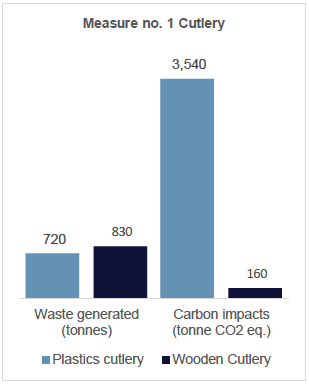
Measure No 2
Material/item to be restricted: Plastics plates
The alternative option: Wax-coated Paper Plates
Notes:
SEA criteria: Will the alternative option contribute to the reduction of greenhouse gas (GHG) emissions generated in Scotland?
Score: Significant positive effect
Commentary: Our analysis shows that the alternative option can reduce the carbon impacts by 70% (i.e., 1,700 t CO2 eq.).
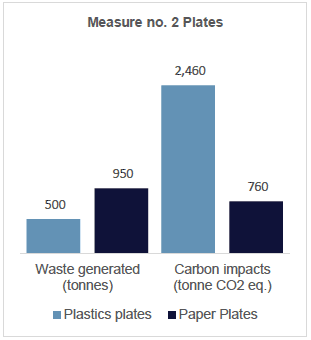
Measure No 3
Material/item to be restricted: Plastic beverage stirrer
The alternative option: Wooden Stirrer
Notes:
SEA criteria: Will the alternative option contribute to the reduction of greenhouse gas (GHG) emissions generated in Scotland?
Score: Minor positive effect
Commentary: Our analysis shows that the alternative option can reduce the carbon impacts by 90% (i.e., 28 t CO2 eq.).
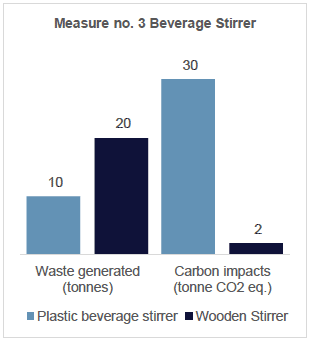
Measure No 4
Material/item to be restricted: Plastic straws
The alternative option: Wax-lined paper straws
Notes:
SEA criteria: Will the alternative option contribute to the reduction of greenhouse gas (GHG) emissions generated in Scotland?
Score: Significant positive effect
Commentary: Our analysis shows that the alternative option can reduce the carbon impacts by 70% (i.e., 550 t CO2 eq.).
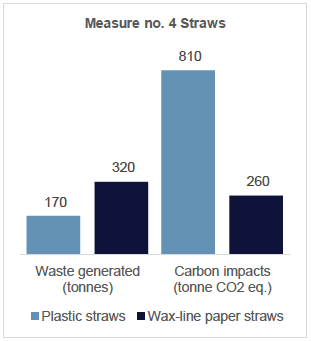
Measure No 5
Material/item to be restricted: Plastic balloon sticks
The alternative option: Cardboard balloon sticks
Notes:
SEA criteria: Will the alternative option contribute to the reduction of greenhouse gas (GHG) emissions generated in Scotland?
Score: Minor positive effect
Commentary: Our analysis shows that the alternative option can reduce the carbon impacts by 70% (i.e., 30 t CO2 eq.).
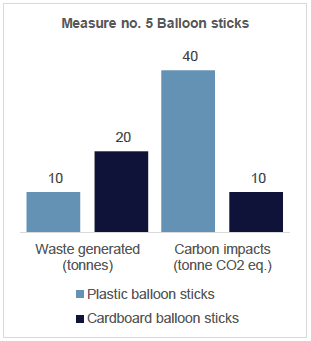
Measure No 6
Material/item to be restricted: Food containers made of expanded polystyrene
The alternative option: Wax-coated cardboard boxes
Notes:
SEA criteria: Will the alternative option contribute to the reduction of greenhouse gas (GHG) emissions generated in Scotland?
Score: Significant positive effect
Commentary: Our analysis shows that the alternative option can reduce the carbon impacts by 50% (i.e., 1,100 t CO2 eq.).
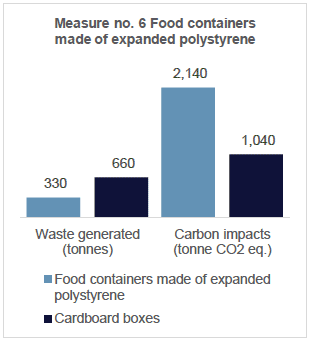
Measure No 7
Material/item to be restricted: Cups and beverage containers made of expanded polystyrene
The alternative option: Plastic-coated paper cups
Notes:
SEA criteria: Will the alternative option contribute to the reduction of greenhouse gas (GHG) emissions generated in Scotland?
Score: Minor negative effect
Commentary: Our analysis shows that the alternative option can potentially increase the carbon impacts by 100% (i.e., 680 t CO2 eq.).
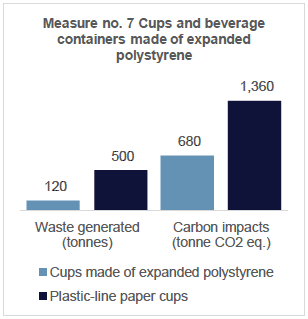
Measure No 8
Material/item to be restricted: Oxo-degradable HDPE
The alternative option: Conventional HDPE
Notes:
SEA criteria: Will the alternative option contribute to the reduction of greenhouse gas (GHG) emissions generated in Scotland?
Score: Minor positive effect
Commentary: Our analysis shows that the alternative option can reduce the carbon impacts by 10% (i.e. 80 t CO2 eq.).
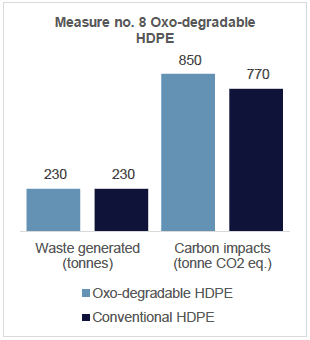
4.4 Mitigation and Enhancement
The majority of single-use non-plastic items that would likely replace single-use plastic products are expected to achieve a reduction in greenhouse gas emissions. This intervention should not however undermine the substantial carbon savings attributed to shifting from single-use to multi-use items, such as replacing single-use plastic-coated paper cups with reusable cups. World literature is abundant with studies that have quantitatively confirmed that multi-use scenarios (and in particular with respect to cups and food containers) tend to have higher carbon savings than all single-use options.[53]
Replacing single-use plastic products with reusable, non-plastic alternatives will hold obvious emissions benefits as stated above. If no product were required at all (single-use plastic or otherwise), this would ultimately achieve the highest carbon saving, as reported by numerous studies published in this area. However, there are obvious practical implications with such a scenario.
Contact
Email: SUPD@gov.scot
There is a problem
Thanks for your feedback